MOD005913 - Vulnerable Persons: A Review of Care Interventions
VerifiedAdded on 2023/05/30
|13
|3355
|440
Case Study
AI Summary
This case study examines care interventions for vulnerable persons, focusing on a widow named Clara who uses negative coping mechanisms after her husband's death, leading to financial exploitation through fraudulent competitions. The study discusses safeguarding principles and relevant legislation in the United Kingdom, including the Data Protection Act 1998, Human Rights Act 1998, and the Care Act 2014. It identifies Clara as an adult at risk and proposes two care interventions: making safeguarding personal and positive risk-taking. The first intervention involves empowering Clara to make her own decisions regarding her safety and well-being, while the second focuses on balancing the risks and benefits of her choices, particularly concerning her financial state and gambling habits. The analysis also addresses potential drawbacks of these interventions, such as Clara's reluctance to attend therapy, highlighting the complexities of safeguarding vulnerable adults.

VULNERABLE PERSONS 1
REVIEW REGARDING A CASE STUDY ON VULNERABLE
PERSONS
Name:
Course:
Professor:
Name of school:
City/State:
Date:
REVIEW REGARDING A CASE STUDY ON VULNERABLE
PERSONS
Name:
Course:
Professor:
Name of school:
City/State:
Date:
Paraphrase This Document
Need a fresh take? Get an instant paraphrase of this document with our AI Paraphraser
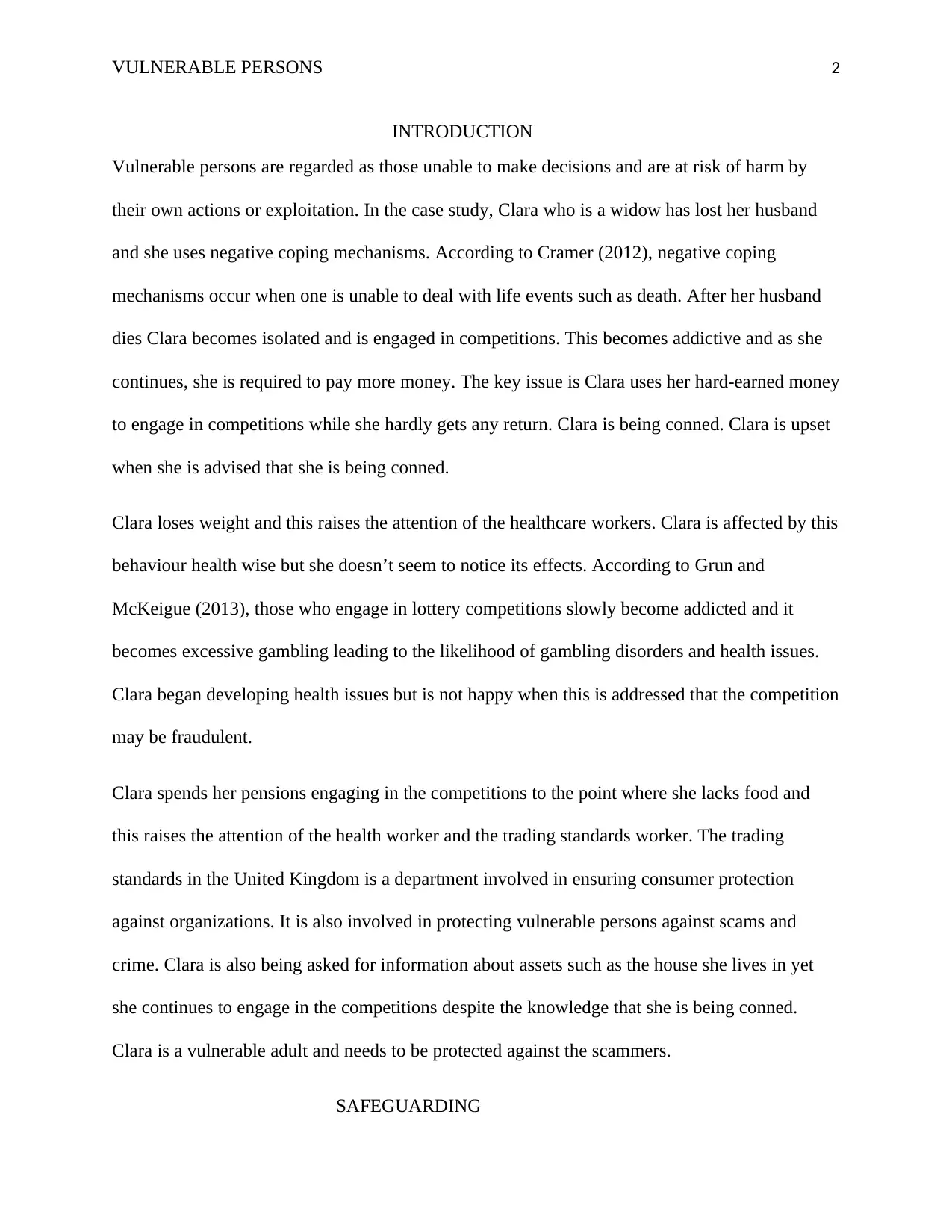
VULNERABLE PERSONS 2
INTRODUCTION
Vulnerable persons are regarded as those unable to make decisions and are at risk of harm by
their own actions or exploitation. In the case study, Clara who is a widow has lost her husband
and she uses negative coping mechanisms. According to Cramer (2012), negative coping
mechanisms occur when one is unable to deal with life events such as death. After her husband
dies Clara becomes isolated and is engaged in competitions. This becomes addictive and as she
continues, she is required to pay more money. The key issue is Clara uses her hard-earned money
to engage in competitions while she hardly gets any return. Clara is being conned. Clara is upset
when she is advised that she is being conned.
Clara loses weight and this raises the attention of the healthcare workers. Clara is affected by this
behaviour health wise but she doesn’t seem to notice its effects. According to Grun and
McKeigue (2013), those who engage in lottery competitions slowly become addicted and it
becomes excessive gambling leading to the likelihood of gambling disorders and health issues.
Clara began developing health issues but is not happy when this is addressed that the competition
may be fraudulent.
Clara spends her pensions engaging in the competitions to the point where she lacks food and
this raises the attention of the health worker and the trading standards worker. The trading
standards in the United Kingdom is a department involved in ensuring consumer protection
against organizations. It is also involved in protecting vulnerable persons against scams and
crime. Clara is also being asked for information about assets such as the house she lives in yet
she continues to engage in the competitions despite the knowledge that she is being conned.
Clara is a vulnerable adult and needs to be protected against the scammers.
SAFEGUARDING
INTRODUCTION
Vulnerable persons are regarded as those unable to make decisions and are at risk of harm by
their own actions or exploitation. In the case study, Clara who is a widow has lost her husband
and she uses negative coping mechanisms. According to Cramer (2012), negative coping
mechanisms occur when one is unable to deal with life events such as death. After her husband
dies Clara becomes isolated and is engaged in competitions. This becomes addictive and as she
continues, she is required to pay more money. The key issue is Clara uses her hard-earned money
to engage in competitions while she hardly gets any return. Clara is being conned. Clara is upset
when she is advised that she is being conned.
Clara loses weight and this raises the attention of the healthcare workers. Clara is affected by this
behaviour health wise but she doesn’t seem to notice its effects. According to Grun and
McKeigue (2013), those who engage in lottery competitions slowly become addicted and it
becomes excessive gambling leading to the likelihood of gambling disorders and health issues.
Clara began developing health issues but is not happy when this is addressed that the competition
may be fraudulent.
Clara spends her pensions engaging in the competitions to the point where she lacks food and
this raises the attention of the health worker and the trading standards worker. The trading
standards in the United Kingdom is a department involved in ensuring consumer protection
against organizations. It is also involved in protecting vulnerable persons against scams and
crime. Clara is also being asked for information about assets such as the house she lives in yet
she continues to engage in the competitions despite the knowledge that she is being conned.
Clara is a vulnerable adult and needs to be protected against the scammers.
SAFEGUARDING
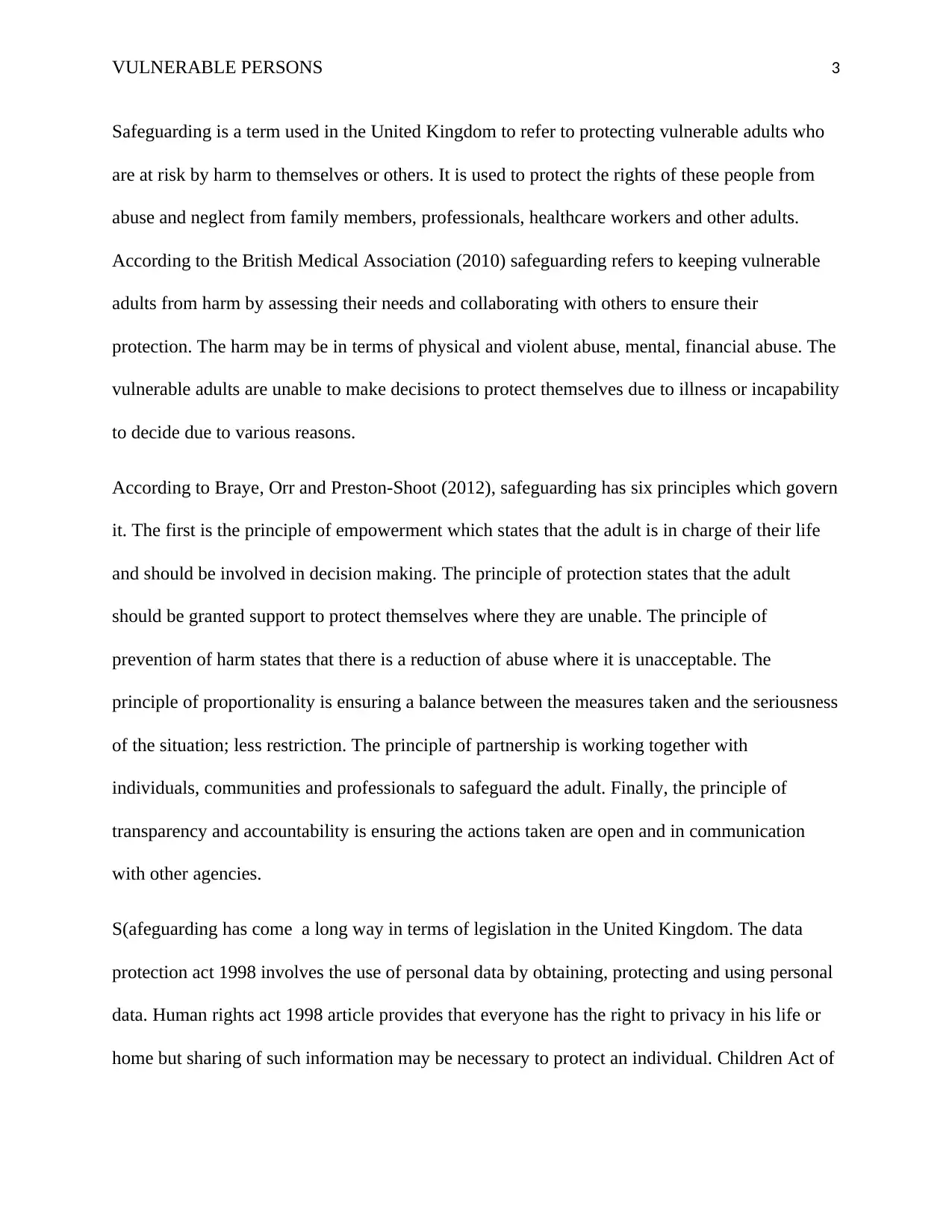
VULNERABLE PERSONS 3
Safeguarding is a term used in the United Kingdom to refer to protecting vulnerable adults who
are at risk by harm to themselves or others. It is used to protect the rights of these people from
abuse and neglect from family members, professionals, healthcare workers and other adults.
According to the British Medical Association (2010) safeguarding refers to keeping vulnerable
adults from harm by assessing their needs and collaborating with others to ensure their
protection. The harm may be in terms of physical and violent abuse, mental, financial abuse. The
vulnerable adults are unable to make decisions to protect themselves due to illness or incapability
to decide due to various reasons.
According to Braye, Orr and Preston-Shoot (2012), safeguarding has six principles which govern
it. The first is the principle of empowerment which states that the adult is in charge of their life
and should be involved in decision making. The principle of protection states that the adult
should be granted support to protect themselves where they are unable. The principle of
prevention of harm states that there is a reduction of abuse where it is unacceptable. The
principle of proportionality is ensuring a balance between the measures taken and the seriousness
of the situation; less restriction. The principle of partnership is working together with
individuals, communities and professionals to safeguard the adult. Finally, the principle of
transparency and accountability is ensuring the actions taken are open and in communication
with other agencies.
S(afeguarding has come a long way in terms of legislation in the United Kingdom. The data
protection act 1998 involves the use of personal data by obtaining, protecting and using personal
data. Human rights act 1998 article provides that everyone has the right to privacy in his life or
home but sharing of such information may be necessary to protect an individual. Children Act of
Safeguarding is a term used in the United Kingdom to refer to protecting vulnerable adults who
are at risk by harm to themselves or others. It is used to protect the rights of these people from
abuse and neglect from family members, professionals, healthcare workers and other adults.
According to the British Medical Association (2010) safeguarding refers to keeping vulnerable
adults from harm by assessing their needs and collaborating with others to ensure their
protection. The harm may be in terms of physical and violent abuse, mental, financial abuse. The
vulnerable adults are unable to make decisions to protect themselves due to illness or incapability
to decide due to various reasons.
According to Braye, Orr and Preston-Shoot (2012), safeguarding has six principles which govern
it. The first is the principle of empowerment which states that the adult is in charge of their life
and should be involved in decision making. The principle of protection states that the adult
should be granted support to protect themselves where they are unable. The principle of
prevention of harm states that there is a reduction of abuse where it is unacceptable. The
principle of proportionality is ensuring a balance between the measures taken and the seriousness
of the situation; less restriction. The principle of partnership is working together with
individuals, communities and professionals to safeguard the adult. Finally, the principle of
transparency and accountability is ensuring the actions taken are open and in communication
with other agencies.
S(afeguarding has come a long way in terms of legislation in the United Kingdom. The data
protection act 1998 involves the use of personal data by obtaining, protecting and using personal
data. Human rights act 1998 article provides that everyone has the right to privacy in his life or
home but sharing of such information may be necessary to protect an individual. Children Act of
⊘ This is a preview!⊘
Do you want full access?
Subscribe today to unlock all pages.

Trusted by 1+ million students worldwide
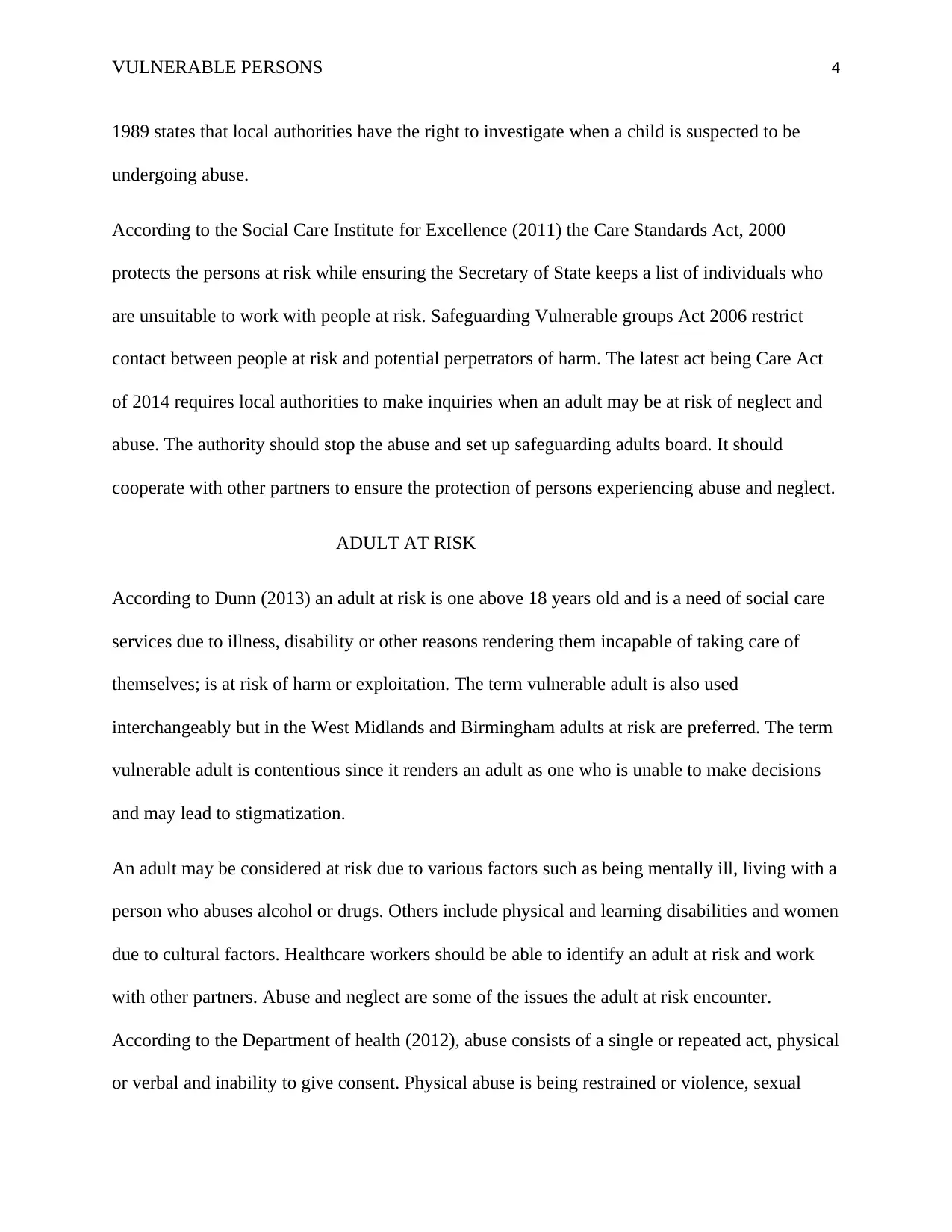
VULNERABLE PERSONS 4
1989 states that local authorities have the right to investigate when a child is suspected to be
undergoing abuse.
According to the Social Care Institute for Excellence (2011) the Care Standards Act, 2000
protects the persons at risk while ensuring the Secretary of State keeps a list of individuals who
are unsuitable to work with people at risk. Safeguarding Vulnerable groups Act 2006 restrict
contact between people at risk and potential perpetrators of harm. The latest act being Care Act
of 2014 requires local authorities to make inquiries when an adult may be at risk of neglect and
abuse. The authority should stop the abuse and set up safeguarding adults board. It should
cooperate with other partners to ensure the protection of persons experiencing abuse and neglect.
ADULT AT RISK
According to Dunn (2013) an adult at risk is one above 18 years old and is a need of social care
services due to illness, disability or other reasons rendering them incapable of taking care of
themselves; is at risk of harm or exploitation. The term vulnerable adult is also used
interchangeably but in the West Midlands and Birmingham adults at risk are preferred. The term
vulnerable adult is contentious since it renders an adult as one who is unable to make decisions
and may lead to stigmatization.
An adult may be considered at risk due to various factors such as being mentally ill, living with a
person who abuses alcohol or drugs. Others include physical and learning disabilities and women
due to cultural factors. Healthcare workers should be able to identify an adult at risk and work
with other partners. Abuse and neglect are some of the issues the adult at risk encounter.
According to the Department of health (2012), abuse consists of a single or repeated act, physical
or verbal and inability to give consent. Physical abuse is being restrained or violence, sexual
1989 states that local authorities have the right to investigate when a child is suspected to be
undergoing abuse.
According to the Social Care Institute for Excellence (2011) the Care Standards Act, 2000
protects the persons at risk while ensuring the Secretary of State keeps a list of individuals who
are unsuitable to work with people at risk. Safeguarding Vulnerable groups Act 2006 restrict
contact between people at risk and potential perpetrators of harm. The latest act being Care Act
of 2014 requires local authorities to make inquiries when an adult may be at risk of neglect and
abuse. The authority should stop the abuse and set up safeguarding adults board. It should
cooperate with other partners to ensure the protection of persons experiencing abuse and neglect.
ADULT AT RISK
According to Dunn (2013) an adult at risk is one above 18 years old and is a need of social care
services due to illness, disability or other reasons rendering them incapable of taking care of
themselves; is at risk of harm or exploitation. The term vulnerable adult is also used
interchangeably but in the West Midlands and Birmingham adults at risk are preferred. The term
vulnerable adult is contentious since it renders an adult as one who is unable to make decisions
and may lead to stigmatization.
An adult may be considered at risk due to various factors such as being mentally ill, living with a
person who abuses alcohol or drugs. Others include physical and learning disabilities and women
due to cultural factors. Healthcare workers should be able to identify an adult at risk and work
with other partners. Abuse and neglect are some of the issues the adult at risk encounter.
According to the Department of health (2012), abuse consists of a single or repeated act, physical
or verbal and inability to give consent. Physical abuse is being restrained or violence, sexual
Paraphrase This Document
Need a fresh take? Get an instant paraphrase of this document with our AI Paraphraser

VULNERABLE PERSONS 5
abuse is giving or receiving forceful sexual acts, financial abuse is fraud of assets, coercion of
inheritance and theft.
FIRST CARE INTERVENTION
The intervention chosen is making safeguarding personal for the adult at risk. Safeguarding is
protecting the vulnerable person at risk. According to Lawson, Lewis and Williams (2014)
making safeguarding personal refers to involving the individual at risk in making their own
decisions while at the same time directing to improve their own safety. The professional in health
and social care involve the adult in decision making and formal proceedings. The making
safeguarding personal intervention involves planning outcomes with the person, supporting and
empowering the person at risk to solve the circumstance putting them at risk. This approach is
person-centred as it emphasizes the need for the adult to be in control. The individual is better
informed on safeguarding and sets the outcomes they aim to reach. They set the guidelines they
want to follow during the process.
In Clara’s case study Clara has enough mental capacity to judge that what she is doing is risky
and it’s a scam. According to Manthrope and Samsi (2012), it is important to assess the mental
capability of the adult at risk before commencing on safeguarding. There will be an assessment
of the risk or financial abuse Clara is going through. Clara is taken through the process of
safeguarding by Safeguarding coordinators who work together with the Adult Safeguarding
Board. Clara is informed on why engaging in these competitions is dangerous for her in terms of
health and addiction. The fact that she hasn’t received any of her money back should be reason
enough to stop participating. Clara is given an opportunity to choose her willingness to quit
abuse is giving or receiving forceful sexual acts, financial abuse is fraud of assets, coercion of
inheritance and theft.
FIRST CARE INTERVENTION
The intervention chosen is making safeguarding personal for the adult at risk. Safeguarding is
protecting the vulnerable person at risk. According to Lawson, Lewis and Williams (2014)
making safeguarding personal refers to involving the individual at risk in making their own
decisions while at the same time directing to improve their own safety. The professional in health
and social care involve the adult in decision making and formal proceedings. The making
safeguarding personal intervention involves planning outcomes with the person, supporting and
empowering the person at risk to solve the circumstance putting them at risk. This approach is
person-centred as it emphasizes the need for the adult to be in control. The individual is better
informed on safeguarding and sets the outcomes they aim to reach. They set the guidelines they
want to follow during the process.
In Clara’s case study Clara has enough mental capacity to judge that what she is doing is risky
and it’s a scam. According to Manthrope and Samsi (2012), it is important to assess the mental
capability of the adult at risk before commencing on safeguarding. There will be an assessment
of the risk or financial abuse Clara is going through. Clara is taken through the process of
safeguarding by Safeguarding coordinators who work together with the Adult Safeguarding
Board. Clara is informed on why engaging in these competitions is dangerous for her in terms of
health and addiction. The fact that she hasn’t received any of her money back should be reason
enough to stop participating. Clara is given an opportunity to choose her willingness to quit
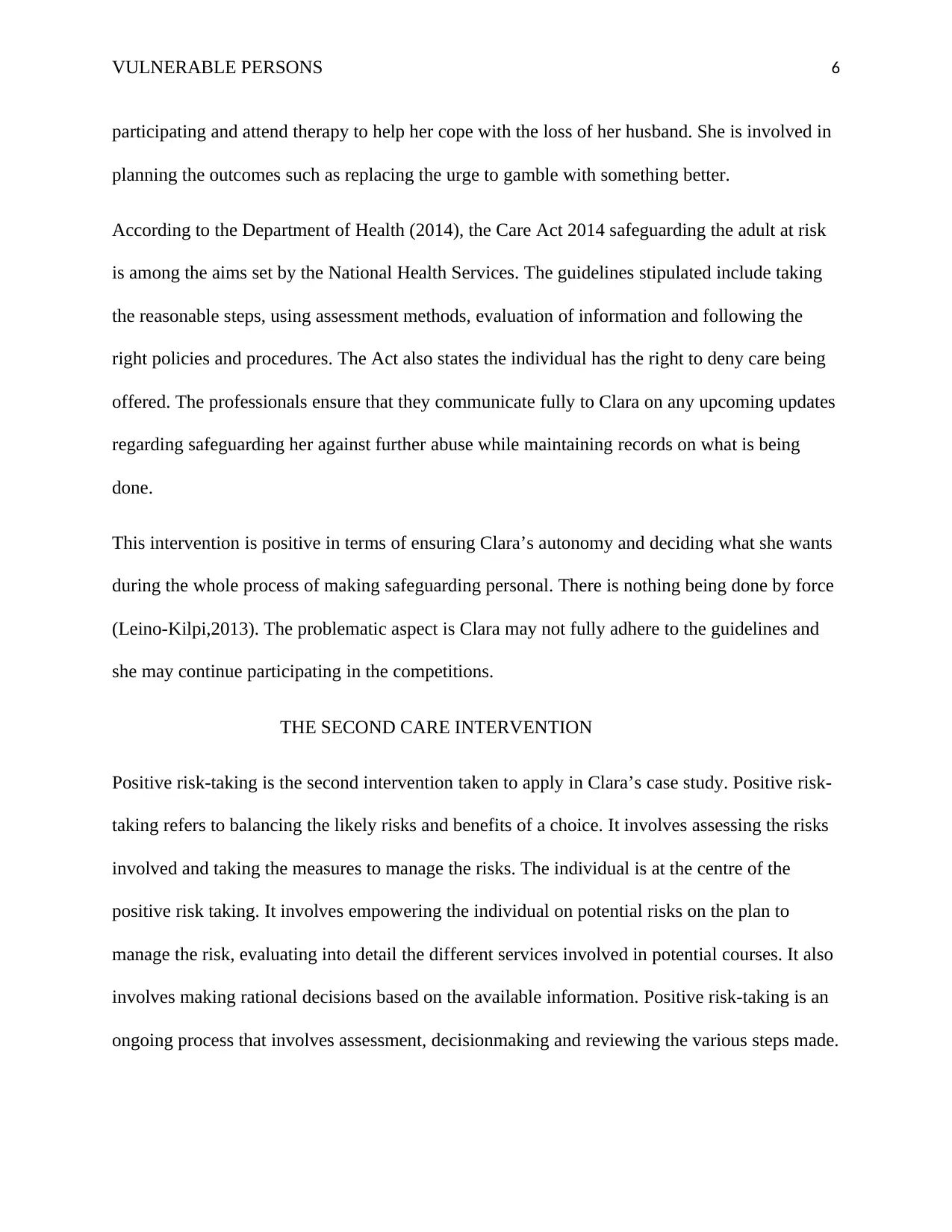
VULNERABLE PERSONS 6
participating and attend therapy to help her cope with the loss of her husband. She is involved in
planning the outcomes such as replacing the urge to gamble with something better.
According to the Department of Health (2014), the Care Act 2014 safeguarding the adult at risk
is among the aims set by the National Health Services. The guidelines stipulated include taking
the reasonable steps, using assessment methods, evaluation of information and following the
right policies and procedures. The Act also states the individual has the right to deny care being
offered. The professionals ensure that they communicate fully to Clara on any upcoming updates
regarding safeguarding her against further abuse while maintaining records on what is being
done.
This intervention is positive in terms of ensuring Clara’s autonomy and deciding what she wants
during the whole process of making safeguarding personal. There is nothing being done by force
(Leino-Kilpi,2013). The problematic aspect is Clara may not fully adhere to the guidelines and
she may continue participating in the competitions.
THE SECOND CARE INTERVENTION
Positive risk-taking is the second intervention taken to apply in Clara’s case study. Positive risk-
taking refers to balancing the likely risks and benefits of a choice. It involves assessing the risks
involved and taking the measures to manage the risks. The individual is at the centre of the
positive risk taking. It involves empowering the individual on potential risks on the plan to
manage the risk, evaluating into detail the different services involved in potential courses. It also
involves making rational decisions based on the available information. Positive risk-taking is an
ongoing process that involves assessment, decisionmaking and reviewing the various steps made.
participating and attend therapy to help her cope with the loss of her husband. She is involved in
planning the outcomes such as replacing the urge to gamble with something better.
According to the Department of Health (2014), the Care Act 2014 safeguarding the adult at risk
is among the aims set by the National Health Services. The guidelines stipulated include taking
the reasonable steps, using assessment methods, evaluation of information and following the
right policies and procedures. The Act also states the individual has the right to deny care being
offered. The professionals ensure that they communicate fully to Clara on any upcoming updates
regarding safeguarding her against further abuse while maintaining records on what is being
done.
This intervention is positive in terms of ensuring Clara’s autonomy and deciding what she wants
during the whole process of making safeguarding personal. There is nothing being done by force
(Leino-Kilpi,2013). The problematic aspect is Clara may not fully adhere to the guidelines and
she may continue participating in the competitions.
THE SECOND CARE INTERVENTION
Positive risk-taking is the second intervention taken to apply in Clara’s case study. Positive risk-
taking refers to balancing the likely risks and benefits of a choice. It involves assessing the risks
involved and taking the measures to manage the risks. The individual is at the centre of the
positive risk taking. It involves empowering the individual on potential risks on the plan to
manage the risk, evaluating into detail the different services involved in potential courses. It also
involves making rational decisions based on the available information. Positive risk-taking is an
ongoing process that involves assessment, decisionmaking and reviewing the various steps made.
⊘ This is a preview!⊘
Do you want full access?
Subscribe today to unlock all pages.

Trusted by 1+ million students worldwide

VULNERABLE PERSONS 7
According to Banks (2012) identification of the risky behaviour is done, stages in the plan and
the various challenges that may be encountered in the process to reduce harm.
In this situation, Clara is given the right to make her own decision regarding her financial state.
The risks involved in Clara’s situation is her health is jeopardized due to gambling and the
scammers are asking for information on her fixed assets. According to Morgan (2014), positive
risk-taking involves directing the adult at risk on the consequences of their various actions. Clara
is guided on the risks of continuous participation in the competitions and spending her pension in
the puzzles. The professional emphasizes the need to save the money rather than spending it
while she attends therapy for her complicate grieving. Clara is made to understand the need to
stop engaging in the competitions as there are more potential benefits and minimize harms.
The positive risk-taking is important because it teaches the importance of making the right
decisions while at the same time allowing the individual to make their own choices. It
demonstrates the consequences of a certain action if the adult at risk goes ahead to perform the
action. According to Morgan and Andrews (2016), the benefit of positive risk-taking applies to
rational decisionmaking. As the Care Act, 2014 states the principle of empowerment states the
individual should be given the ability to make their own choices while that of the partnership is
ensuring all the key players play their role including the legal advocates.
The positive risk-taking intervention has several benefits including granting the individual at risk
the autonomy to make decisions and indicating the various disadvantages. This would be really
positive for Clara since she will have the willpower to stop participating in competitions and
address the underlying issues. The disadvantages include the difficult process of engaging
various key holders in the risk assessment such as the therapist and the legal advocates.
According to Banks (2012) identification of the risky behaviour is done, stages in the plan and
the various challenges that may be encountered in the process to reduce harm.
In this situation, Clara is given the right to make her own decision regarding her financial state.
The risks involved in Clara’s situation is her health is jeopardized due to gambling and the
scammers are asking for information on her fixed assets. According to Morgan (2014), positive
risk-taking involves directing the adult at risk on the consequences of their various actions. Clara
is guided on the risks of continuous participation in the competitions and spending her pension in
the puzzles. The professional emphasizes the need to save the money rather than spending it
while she attends therapy for her complicate grieving. Clara is made to understand the need to
stop engaging in the competitions as there are more potential benefits and minimize harms.
The positive risk-taking is important because it teaches the importance of making the right
decisions while at the same time allowing the individual to make their own choices. It
demonstrates the consequences of a certain action if the adult at risk goes ahead to perform the
action. According to Morgan and Andrews (2016), the benefit of positive risk-taking applies to
rational decisionmaking. As the Care Act, 2014 states the principle of empowerment states the
individual should be given the ability to make their own choices while that of the partnership is
ensuring all the key players play their role including the legal advocates.
The positive risk-taking intervention has several benefits including granting the individual at risk
the autonomy to make decisions and indicating the various disadvantages. This would be really
positive for Clara since she will have the willpower to stop participating in competitions and
address the underlying issues. The disadvantages include the difficult process of engaging
various key holders in the risk assessment such as the therapist and the legal advocates.
Paraphrase This Document
Need a fresh take? Get an instant paraphrase of this document with our AI Paraphraser
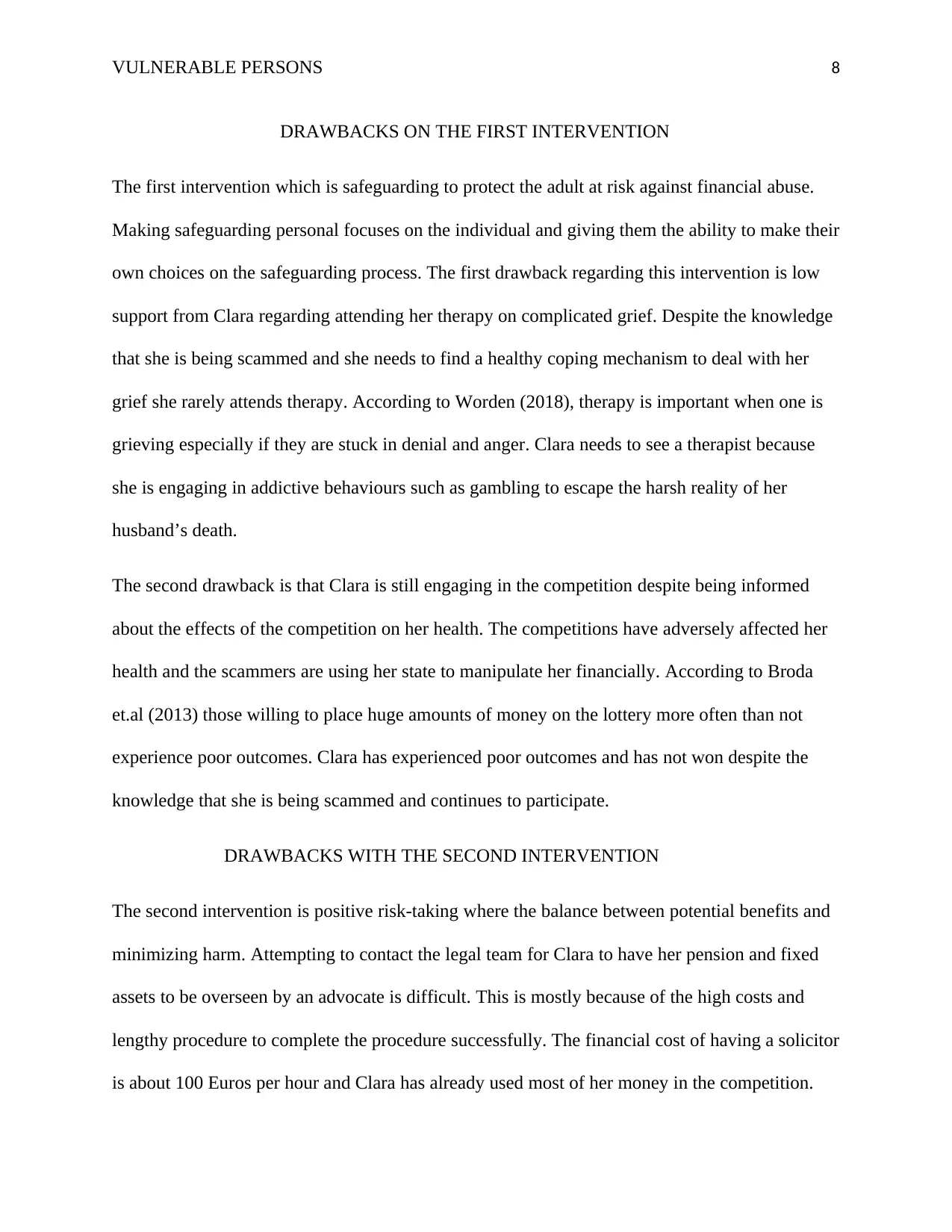
VULNERABLE PERSONS 8
DRAWBACKS ON THE FIRST INTERVENTION
The first intervention which is safeguarding to protect the adult at risk against financial abuse.
Making safeguarding personal focuses on the individual and giving them the ability to make their
own choices on the safeguarding process. The first drawback regarding this intervention is low
support from Clara regarding attending her therapy on complicated grief. Despite the knowledge
that she is being scammed and she needs to find a healthy coping mechanism to deal with her
grief she rarely attends therapy. According to Worden (2018), therapy is important when one is
grieving especially if they are stuck in denial and anger. Clara needs to see a therapist because
she is engaging in addictive behaviours such as gambling to escape the harsh reality of her
husband’s death.
The second drawback is that Clara is still engaging in the competition despite being informed
about the effects of the competition on her health. The competitions have adversely affected her
health and the scammers are using her state to manipulate her financially. According to Broda
et.al (2013) those willing to place huge amounts of money on the lottery more often than not
experience poor outcomes. Clara has experienced poor outcomes and has not won despite the
knowledge that she is being scammed and continues to participate.
DRAWBACKS WITH THE SECOND INTERVENTION
The second intervention is positive risk-taking where the balance between potential benefits and
minimizing harm. Attempting to contact the legal team for Clara to have her pension and fixed
assets to be overseen by an advocate is difficult. This is mostly because of the high costs and
lengthy procedure to complete the procedure successfully. The financial cost of having a solicitor
is about 100 Euros per hour and Clara has already used most of her money in the competition.
DRAWBACKS ON THE FIRST INTERVENTION
The first intervention which is safeguarding to protect the adult at risk against financial abuse.
Making safeguarding personal focuses on the individual and giving them the ability to make their
own choices on the safeguarding process. The first drawback regarding this intervention is low
support from Clara regarding attending her therapy on complicated grief. Despite the knowledge
that she is being scammed and she needs to find a healthy coping mechanism to deal with her
grief she rarely attends therapy. According to Worden (2018), therapy is important when one is
grieving especially if they are stuck in denial and anger. Clara needs to see a therapist because
she is engaging in addictive behaviours such as gambling to escape the harsh reality of her
husband’s death.
The second drawback is that Clara is still engaging in the competition despite being informed
about the effects of the competition on her health. The competitions have adversely affected her
health and the scammers are using her state to manipulate her financially. According to Broda
et.al (2013) those willing to place huge amounts of money on the lottery more often than not
experience poor outcomes. Clara has experienced poor outcomes and has not won despite the
knowledge that she is being scammed and continues to participate.
DRAWBACKS WITH THE SECOND INTERVENTION
The second intervention is positive risk-taking where the balance between potential benefits and
minimizing harm. Attempting to contact the legal team for Clara to have her pension and fixed
assets to be overseen by an advocate is difficult. This is mostly because of the high costs and
lengthy procedure to complete the procedure successfully. The financial cost of having a solicitor
is about 100 Euros per hour and Clara has already used most of her money in the competition.
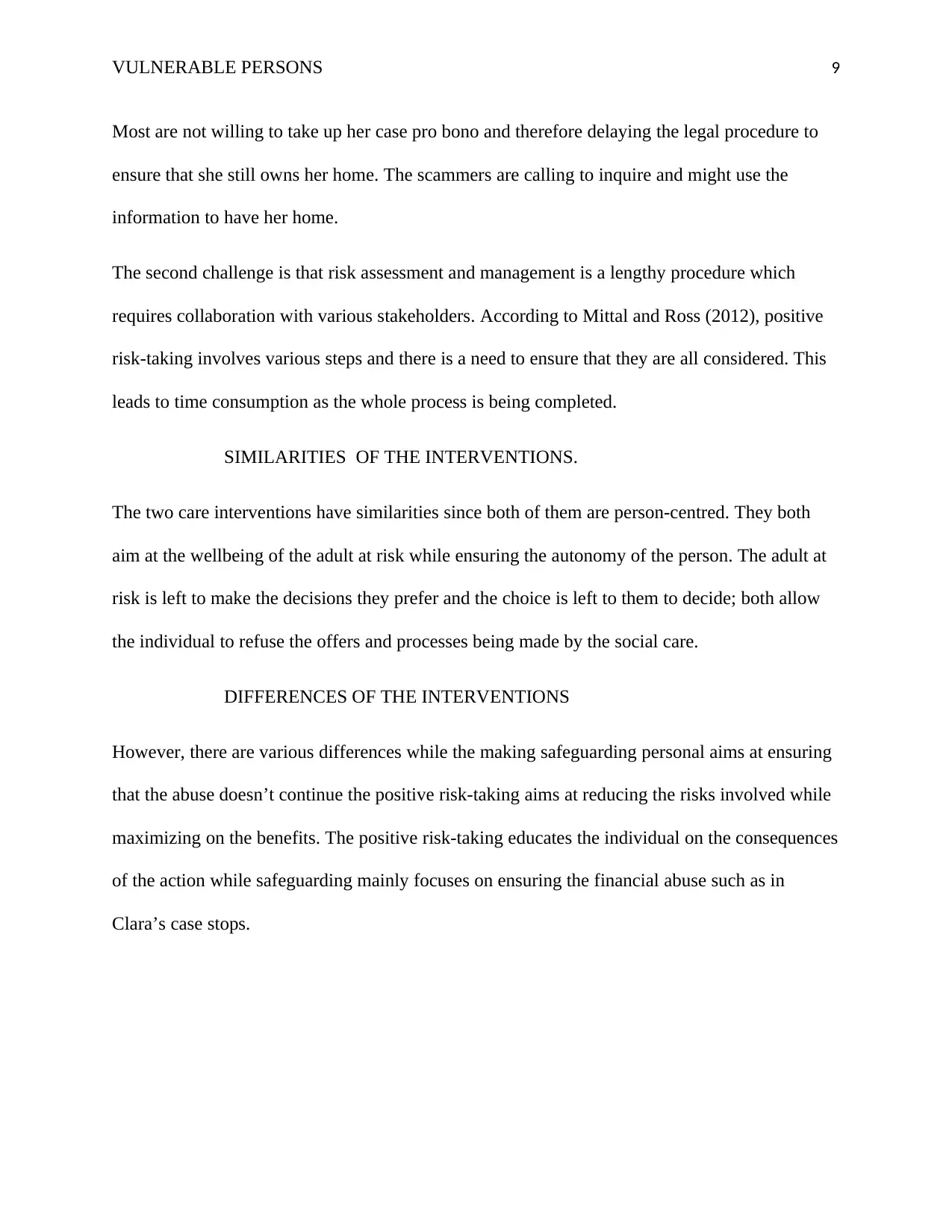
VULNERABLE PERSONS 9
Most are not willing to take up her case pro bono and therefore delaying the legal procedure to
ensure that she still owns her home. The scammers are calling to inquire and might use the
information to have her home.
The second challenge is that risk assessment and management is a lengthy procedure which
requires collaboration with various stakeholders. According to Mittal and Ross (2012), positive
risk-taking involves various steps and there is a need to ensure that they are all considered. This
leads to time consumption as the whole process is being completed.
SIMILARITIES OF THE INTERVENTIONS.
The two care interventions have similarities since both of them are person-centred. They both
aim at the wellbeing of the adult at risk while ensuring the autonomy of the person. The adult at
risk is left to make the decisions they prefer and the choice is left to them to decide; both allow
the individual to refuse the offers and processes being made by the social care.
DIFFERENCES OF THE INTERVENTIONS
However, there are various differences while the making safeguarding personal aims at ensuring
that the abuse doesn’t continue the positive risk-taking aims at reducing the risks involved while
maximizing on the benefits. The positive risk-taking educates the individual on the consequences
of the action while safeguarding mainly focuses on ensuring the financial abuse such as in
Clara’s case stops.
Most are not willing to take up her case pro bono and therefore delaying the legal procedure to
ensure that she still owns her home. The scammers are calling to inquire and might use the
information to have her home.
The second challenge is that risk assessment and management is a lengthy procedure which
requires collaboration with various stakeholders. According to Mittal and Ross (2012), positive
risk-taking involves various steps and there is a need to ensure that they are all considered. This
leads to time consumption as the whole process is being completed.
SIMILARITIES OF THE INTERVENTIONS.
The two care interventions have similarities since both of them are person-centred. They both
aim at the wellbeing of the adult at risk while ensuring the autonomy of the person. The adult at
risk is left to make the decisions they prefer and the choice is left to them to decide; both allow
the individual to refuse the offers and processes being made by the social care.
DIFFERENCES OF THE INTERVENTIONS
However, there are various differences while the making safeguarding personal aims at ensuring
that the abuse doesn’t continue the positive risk-taking aims at reducing the risks involved while
maximizing on the benefits. The positive risk-taking educates the individual on the consequences
of the action while safeguarding mainly focuses on ensuring the financial abuse such as in
Clara’s case stops.
⊘ This is a preview!⊘
Do you want full access?
Subscribe today to unlock all pages.

Trusted by 1+ million students worldwide
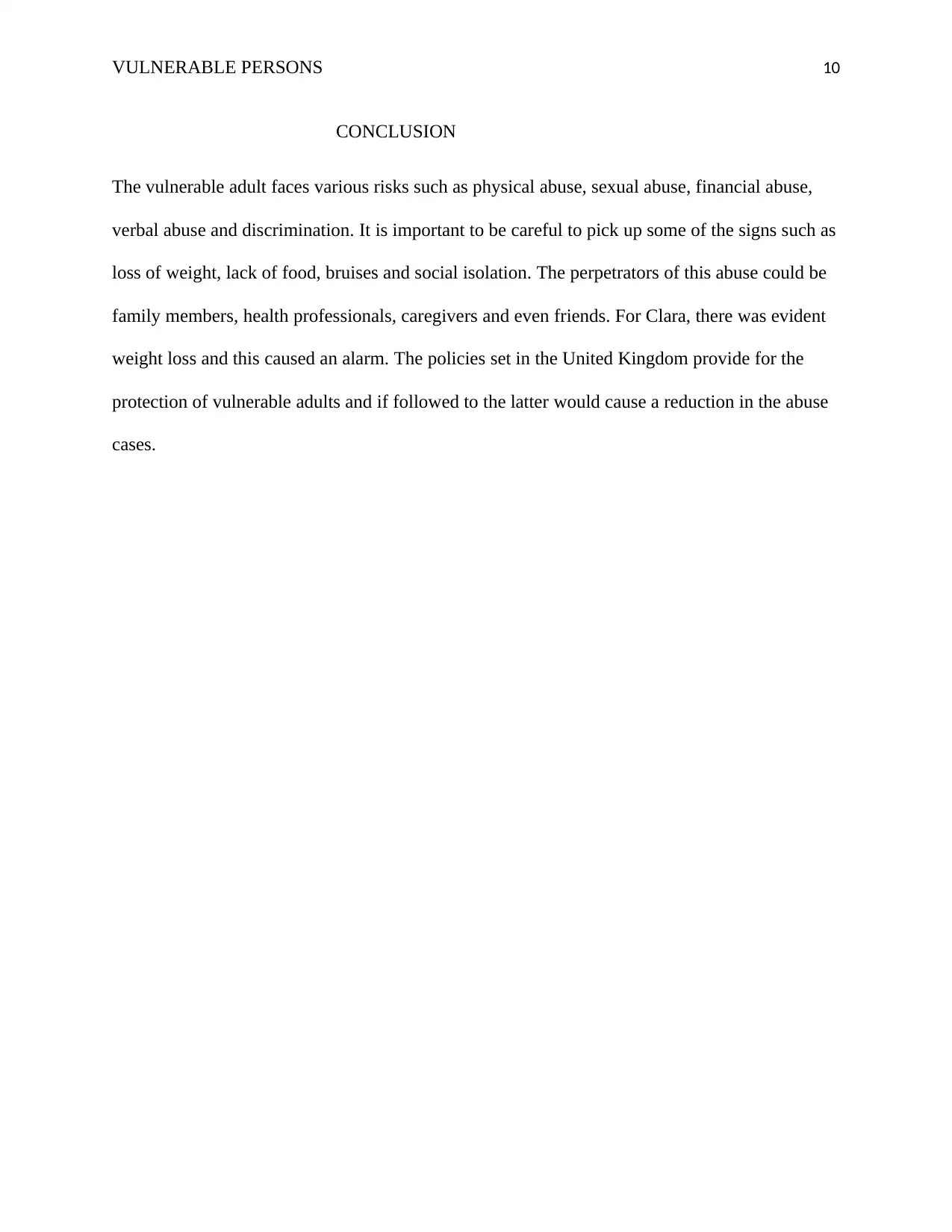
VULNERABLE PERSONS 10
CONCLUSION
The vulnerable adult faces various risks such as physical abuse, sexual abuse, financial abuse,
verbal abuse and discrimination. It is important to be careful to pick up some of the signs such as
loss of weight, lack of food, bruises and social isolation. The perpetrators of this abuse could be
family members, health professionals, caregivers and even friends. For Clara, there was evident
weight loss and this caused an alarm. The policies set in the United Kingdom provide for the
protection of vulnerable adults and if followed to the latter would cause a reduction in the abuse
cases.
CONCLUSION
The vulnerable adult faces various risks such as physical abuse, sexual abuse, financial abuse,
verbal abuse and discrimination. It is important to be careful to pick up some of the signs such as
loss of weight, lack of food, bruises and social isolation. The perpetrators of this abuse could be
family members, health professionals, caregivers and even friends. For Clara, there was evident
weight loss and this caused an alarm. The policies set in the United Kingdom provide for the
protection of vulnerable adults and if followed to the latter would cause a reduction in the abuse
cases.
Paraphrase This Document
Need a fresh take? Get an instant paraphrase of this document with our AI Paraphraser
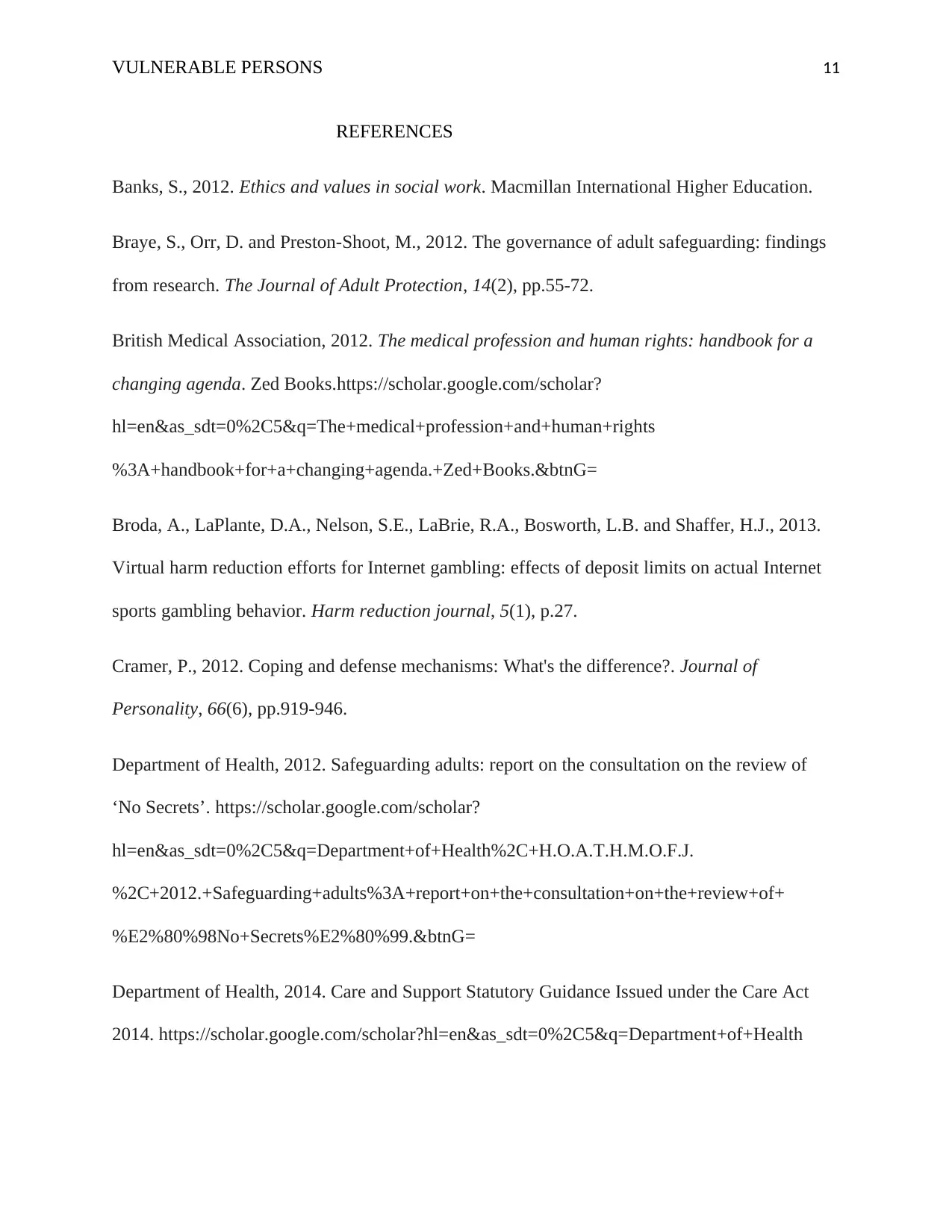
VULNERABLE PERSONS 11
REFERENCES
Banks, S., 2012. Ethics and values in social work. Macmillan International Higher Education.
Braye, S., Orr, D. and Preston-Shoot, M., 2012. The governance of adult safeguarding: findings
from research. The Journal of Adult Protection, 14(2), pp.55-72.
British Medical Association, 2012. The medical profession and human rights: handbook for a
changing agenda. Zed Books.https://scholar.google.com/scholar?
hl=en&as_sdt=0%2C5&q=The+medical+profession+and+human+rights
%3A+handbook+for+a+changing+agenda.+Zed+Books.&btnG=
Broda, A., LaPlante, D.A., Nelson, S.E., LaBrie, R.A., Bosworth, L.B. and Shaffer, H.J., 2013.
Virtual harm reduction efforts for Internet gambling: effects of deposit limits on actual Internet
sports gambling behavior. Harm reduction journal, 5(1), p.27.
Cramer, P., 2012. Coping and defense mechanisms: What's the difference?. Journal of
Personality, 66(6), pp.919-946.
Department of Health, 2012. Safeguarding adults: report on the consultation on the review of
‘No Secrets’. https://scholar.google.com/scholar?
hl=en&as_sdt=0%2C5&q=Department+of+Health%2C+H.O.A.T.H.M.O.F.J.
%2C+2012.+Safeguarding+adults%3A+report+on+the+consultation+on+the+review+of+
%E2%80%98No+Secrets%E2%80%99.&btnG=
Department of Health, 2014. Care and Support Statutory Guidance Issued under the Care Act
2014. https://scholar.google.com/scholar?hl=en&as_sdt=0%2C5&q=Department+of+Health
REFERENCES
Banks, S., 2012. Ethics and values in social work. Macmillan International Higher Education.
Braye, S., Orr, D. and Preston-Shoot, M., 2012. The governance of adult safeguarding: findings
from research. The Journal of Adult Protection, 14(2), pp.55-72.
British Medical Association, 2012. The medical profession and human rights: handbook for a
changing agenda. Zed Books.https://scholar.google.com/scholar?
hl=en&as_sdt=0%2C5&q=The+medical+profession+and+human+rights
%3A+handbook+for+a+changing+agenda.+Zed+Books.&btnG=
Broda, A., LaPlante, D.A., Nelson, S.E., LaBrie, R.A., Bosworth, L.B. and Shaffer, H.J., 2013.
Virtual harm reduction efforts for Internet gambling: effects of deposit limits on actual Internet
sports gambling behavior. Harm reduction journal, 5(1), p.27.
Cramer, P., 2012. Coping and defense mechanisms: What's the difference?. Journal of
Personality, 66(6), pp.919-946.
Department of Health, 2012. Safeguarding adults: report on the consultation on the review of
‘No Secrets’. https://scholar.google.com/scholar?
hl=en&as_sdt=0%2C5&q=Department+of+Health%2C+H.O.A.T.H.M.O.F.J.
%2C+2012.+Safeguarding+adults%3A+report+on+the+consultation+on+the+review+of+
%E2%80%98No+Secrets%E2%80%99.&btnG=
Department of Health, 2014. Care and Support Statutory Guidance Issued under the Care Act
2014. https://scholar.google.com/scholar?hl=en&as_sdt=0%2C5&q=Department+of+Health
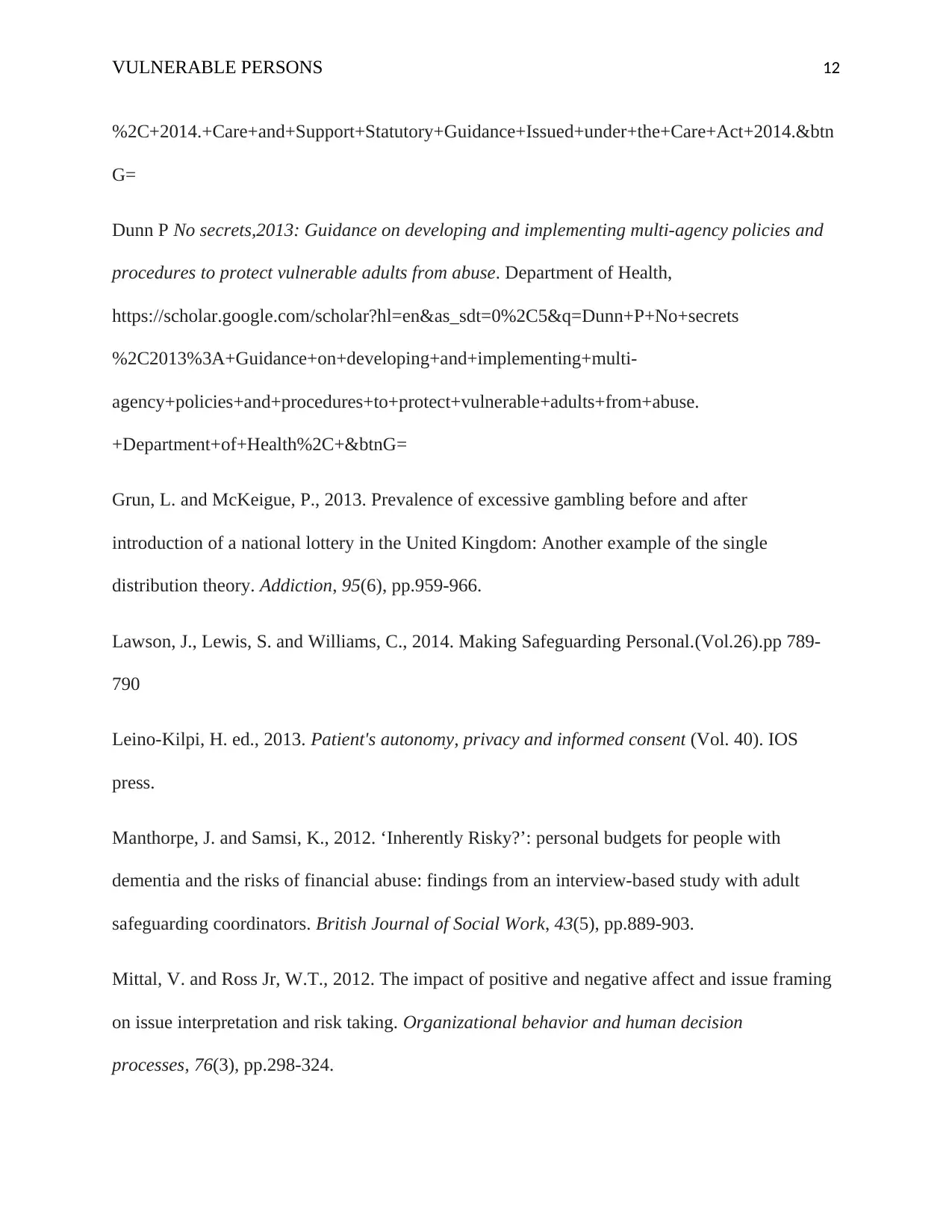
VULNERABLE PERSONS 12
%2C+2014.+Care+and+Support+Statutory+Guidance+Issued+under+the+Care+Act+2014.&btn
G=
Dunn P No secrets,2013: Guidance on developing and implementing multi-agency policies and
procedures to protect vulnerable adults from abuse. Department of Health,
https://scholar.google.com/scholar?hl=en&as_sdt=0%2C5&q=Dunn+P+No+secrets
%2C2013%3A+Guidance+on+developing+and+implementing+multi-
agency+policies+and+procedures+to+protect+vulnerable+adults+from+abuse.
+Department+of+Health%2C+&btnG=
Grun, L. and McKeigue, P., 2013. Prevalence of excessive gambling before and after
introduction of a national lottery in the United Kingdom: Another example of the single
distribution theory. Addiction, 95(6), pp.959-966.
Lawson, J., Lewis, S. and Williams, C., 2014. Making Safeguarding Personal.(Vol.26).pp 789-
790
Leino-Kilpi, H. ed., 2013. Patient's autonomy, privacy and informed consent (Vol. 40). IOS
press.
Manthorpe, J. and Samsi, K., 2012. ‘Inherently Risky?’: personal budgets for people with
dementia and the risks of financial abuse: findings from an interview-based study with adult
safeguarding coordinators. British Journal of Social Work, 43(5), pp.889-903.
Mittal, V. and Ross Jr, W.T., 2012. The impact of positive and negative affect and issue framing
on issue interpretation and risk taking. Organizational behavior and human decision
processes, 76(3), pp.298-324.
%2C+2014.+Care+and+Support+Statutory+Guidance+Issued+under+the+Care+Act+2014.&btn
G=
Dunn P No secrets,2013: Guidance on developing and implementing multi-agency policies and
procedures to protect vulnerable adults from abuse. Department of Health,
https://scholar.google.com/scholar?hl=en&as_sdt=0%2C5&q=Dunn+P+No+secrets
%2C2013%3A+Guidance+on+developing+and+implementing+multi-
agency+policies+and+procedures+to+protect+vulnerable+adults+from+abuse.
+Department+of+Health%2C+&btnG=
Grun, L. and McKeigue, P., 2013. Prevalence of excessive gambling before and after
introduction of a national lottery in the United Kingdom: Another example of the single
distribution theory. Addiction, 95(6), pp.959-966.
Lawson, J., Lewis, S. and Williams, C., 2014. Making Safeguarding Personal.(Vol.26).pp 789-
790
Leino-Kilpi, H. ed., 2013. Patient's autonomy, privacy and informed consent (Vol. 40). IOS
press.
Manthorpe, J. and Samsi, K., 2012. ‘Inherently Risky?’: personal budgets for people with
dementia and the risks of financial abuse: findings from an interview-based study with adult
safeguarding coordinators. British Journal of Social Work, 43(5), pp.889-903.
Mittal, V. and Ross Jr, W.T., 2012. The impact of positive and negative affect and issue framing
on issue interpretation and risk taking. Organizational behavior and human decision
processes, 76(3), pp.298-324.
⊘ This is a preview!⊘
Do you want full access?
Subscribe today to unlock all pages.

Trusted by 1+ million students worldwide
1 out of 13
Related Documents
Your All-in-One AI-Powered Toolkit for Academic Success.
+13062052269
info@desklib.com
Available 24*7 on WhatsApp / Email
![[object Object]](/_next/static/media/star-bottom.7253800d.svg)
Unlock your academic potential
Copyright © 2020–2025 A2Z Services. All Rights Reserved. Developed and managed by ZUCOL.





